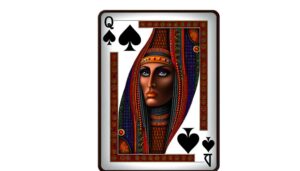Cultural Meaning of Dead Fish and Tree Symbols
The symbols of a dead fish and a tree hold profound meanings across various cultures and eras. Historically, they represent themes of mortality, renewal, and life's cyclical nature.
In mythology, a dead fish often signifies transformation and loss, whereas trees symbolize life, growth, and interconnectedness. Spiritually, these elements embody the processes of decay and rebirth, reflecting internal conflicts and deep-seated fears.
In art, they evoke reflections on existence and the passage of time. Today's interpretations also touch on environmental concerns, illustrating rich, complex layers of symbolism.
For a deeper understanding of their diverse cultural significance, further exploration is essential.

Key Takeaways
- Dead fish symbolize mortality, decay, and transformation across various ancient and modern cultural contexts.
- Trees represent life, growth, renewal, and interconnectedness in numerous mythologies and spiritual beliefs.
- Both symbols reflect themes of life, death, and the cyclical nature of existence.
- In art, dead fish evoke reflections on human existence and the passage of time.
- Modern interpretations of these symbols often critique environmental degradation and human impact on nature.
Historical Significance

The historical significance of the dead fish and tree symbols can be traced back to ancient civilizations. They often represented themes of mortality, renewal, and the cyclical nature of life.
In Egyptian culture, the dead fish was an emblem of death and transformation, reflecting the Nile's life-giving and life-taking properties.
Similarly, the tree in many ancient societies symbolized life, death, and rebirth. It was often depicted in mythology as the World Tree or Tree of Life.
These symbols were not mere artistic expressions but integral components of societal understanding of existence. They embodied philosophical reflections on the transience of life and the promise of regeneration.
Their pervasive use underscores their importance in the collective consciousness of early human civilizations, providing profound insights into their worldview.
Cultural Interpretations
Across various cultures, interpretations of the dead fish and tree symbols have evolved to reflect unique societal values, beliefs, and existential inquiries. These symbols often encapsulate complex cultural narratives and serve as metaphors for broader human experiences.
- Dead Fish: In some cultures, a dead fish symbolizes the end of abundance and prosperity, often linked to environmental degradation or spiritual decay.
- Tree: Conversely, trees are commonly seen as life-givers, embodying growth, connection to ancestors, and the cyclical nature of life, death, and rebirth.
- Combined Symbolism: When dead fish and trees are portrayed together, they may represent the duality of life and death, highlighting the interdependent balance within ecosystems and human existence.
These interpretations underscore the profound interplay between nature and cultural identity.
Dead Fish in Mythology
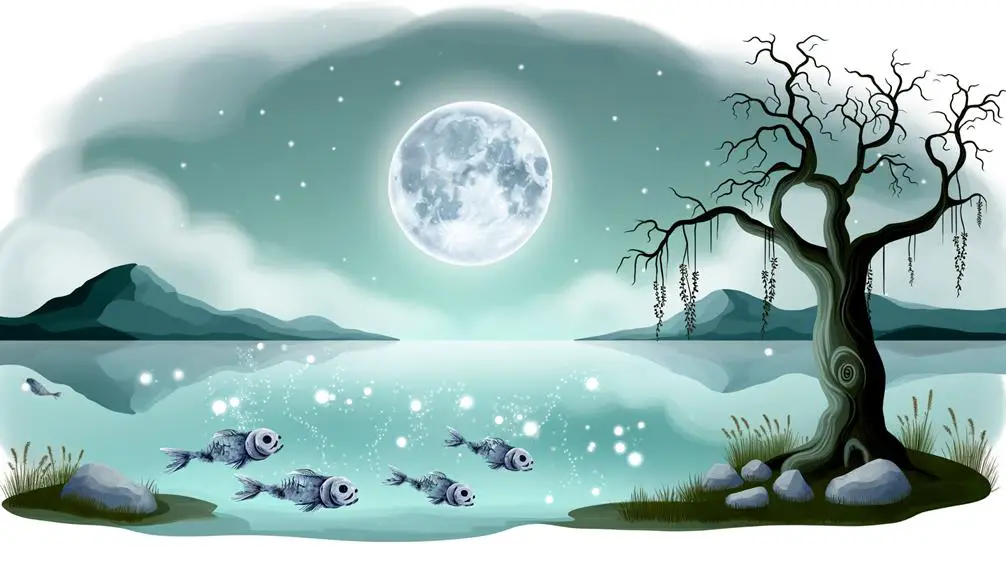
In mythology, dead fish often serve as potent symbols of transformation, loss, and the inexorable passage of time. This imagery captures the cyclical nature of life and death, illustrating themes of renewal and decay. Myths from various cultures use dead fish to convey profound existential messages.
| Culture | Mythological Context | Symbolism |
|---|---|---|
| Ancient Egypt | Linked to the underworld and rebirth | Renewal through death |
| Norse | Represents the end of a cycle | Transformation and new beginnings |
| Celtic | Associated with sacred waters | Loss and the flow of life's energies |
This symbolism transcends mere mortality, inviting contemplation on the ephemeral nature of existence and the inevitability of change.
Tree in Mythology
Throughout various mythological narratives, trees have been revered as powerful symbols representing life, growth, and interconnectedness. Their significance transcends cultures, highlighting their universal appeal.
- Norse Mythology: The Yggdrasil, or World Tree, connects the nine worlds, illustrating the unity and structure of the cosmos.
- Celtic Mythology: The Oak tree, or 'Duir,' symbolizes endurance and strength, often associated with Druids and sacred rituals.
- Hindu Mythology: The Banyan tree, or 'Kalpavriksha,' is considered a wish-fulfilling divine tree, embodying eternal life and fertility.
Analyzing these examples, it becomes evident that trees serve as a conduit for understanding existence, embodying the cyclical nature of life and the profound connection between the earthly and the divine.
Spiritual Meanings
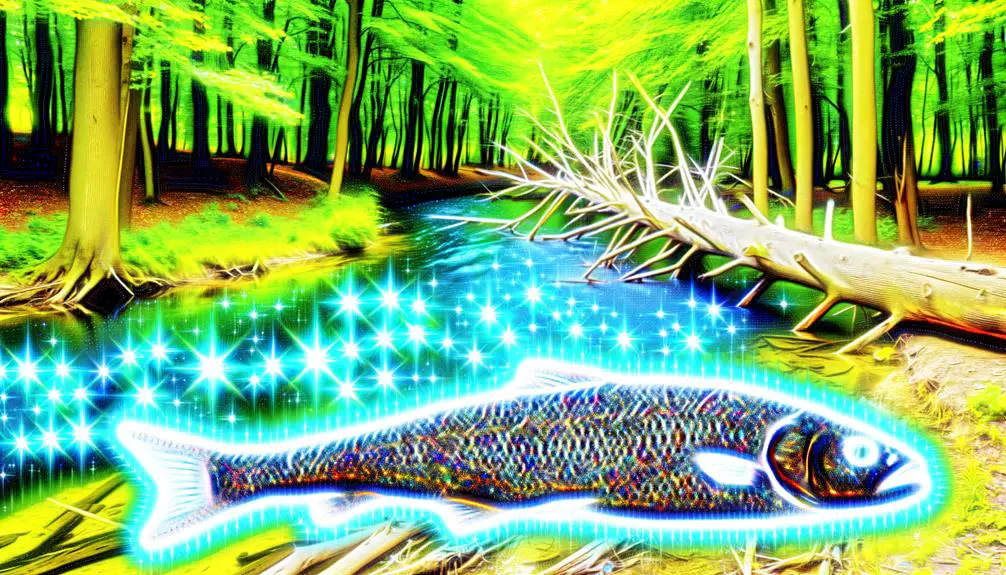
The spiritual meanings of dead fish and trees are deeply embedded in ancient cultures, often symbolizing the cyclical nature of life and death.
These natural elements frequently represent transformation and renewal, highlighting the inevitable processes of decay and rebirth.
Symbolism in Ancient Cultures
Ancient cultures imbued deceased fish and tree symbols with profound spiritual meanings, often linking them to themes of alteration, life circles, and the interconnectedness of the natural world. These symbols were not mere artistic expressions but carried deep, interpretive connotations within various civilizations.
- Alteration: The deceased fish symbol often represented the soul's journey and alteration, particularly in cultures like the Egyptians, where the fish was associated with rebirth and regeneration.
- Life Circles: Trees symbolized the cyclical nature of life, death, and rebirth, evident in Norse mythology's Yggdrasil, the World Tree, encompassing all domains of existence.
- Interconnectedness: Both symbols underscored the unity of life, illustrating how individual elements contribute to a greater, cohesive whole, essential in belief systems like Taoism.
These interpretations reveal a sophisticated understanding of existence.
Nature's Life Cycle
Understanding nature's life cycle through spiritual meanings involves analyzing how different cultures interpret the phases of growth, decay, and renewal in the natural world. In various traditions, these stages are seen as metaphors for human existence and spiritual journeys.
For instance, a tree's growth symbolizes life and energy, while its decay represents the inevitability of death. Conversely, fallen leaves and dead fish often serve as reminders of mortality and the temporary nature of life. These symbols not only underscore the interdependence of life and death but also highlight the cyclical patterns intrinsic to existence.
Therefore, nature's life cycle provides a profound lens through which spiritual beliefs and philosophical reflections about life's impermanence are continuously explored and understood.
Transformation and Renewal
Symbols of transformation and renewal, such as dead fish and trees, often reflect deeper spiritual meanings embedded within cultural and religious narratives. These symbols serve as metaphors for life's cyclical nature and the potential for rebirth and growth.
Dead Fish: In many traditions, dead fish symbolize the end of one phase and the beginning of another, embodying the concept of spiritual resurrection.
Trees: Trees are perennial symbols of renewal, with their seasonal cycles representing life, death, and rebirth.
Cultural Interpretations: Varied across cultures, these symbols highlight universal themes of metamorphosis and continuity, offering insights into human existence and spiritual evolution.
Understanding these symbols allows individuals to perceive a broader, interconnected view of life's perpetual transformations.
Psychological Perspectives
From a psychological perspective, the symbols of dead fish and trees resonate deeply with archetypal interpretations, reflecting universal themes found within the collective unconscious.
These symbols often influence the subconscious mind, revealing inner conflicts, growth, and transformation.
Analyzing these images can therefore provide insight into underlying emotional states and personal development processes.
Archetypal Symbolism Interpretation
Exploring the archetypal symbolism of dead fish and tree imagery through psychological perspectives reveals profound insights into the collective unconscious and individual psyche. From a Jungian standpoint, these symbols tap into universal themes:
- Dead Fish: Represents loss, decay, and the unconscious mind's unearthed traumas or emotions.
- Tree: Signifies growth, stability, and the deeply rooted aspects of one's identity and personal development.
- Interconnectedness: The juxtaposition of dead fish and tree can symbolize the cyclical nature of life and death, regeneration, and transformation.
Such imagery can be viewed as reflecting internal processes, where the death of one aspect (dead fish) can lead to the nourishment and growth of another (tree), offering a pathway to psychological renewal.
Subconscious Mind Influence
The influence of the subconscious mind on the interpretation of dead fish and tree symbols reveals deep-seated emotional and psychological dynamics that shape human behavior and perception. These symbols often emerge in dreams or spontaneous thoughts, indicating unresolved internal conflicts or latent fears.
A dead fish might symbolize feelings of stagnation, loss, or failure, connecting to buried anxieties and a sense of helplessness. Conversely, a tree may represent growth, stability, or life's cycles, tapping into an individual's need for grounding and continuity.
Examining these symbols through the lens of the subconscious allows for a deeper exploration of personal experiences and psychological states, offering insights into how intrinsic narratives influence reactions, decisions, and overall mental health.
Dead Fish in Art
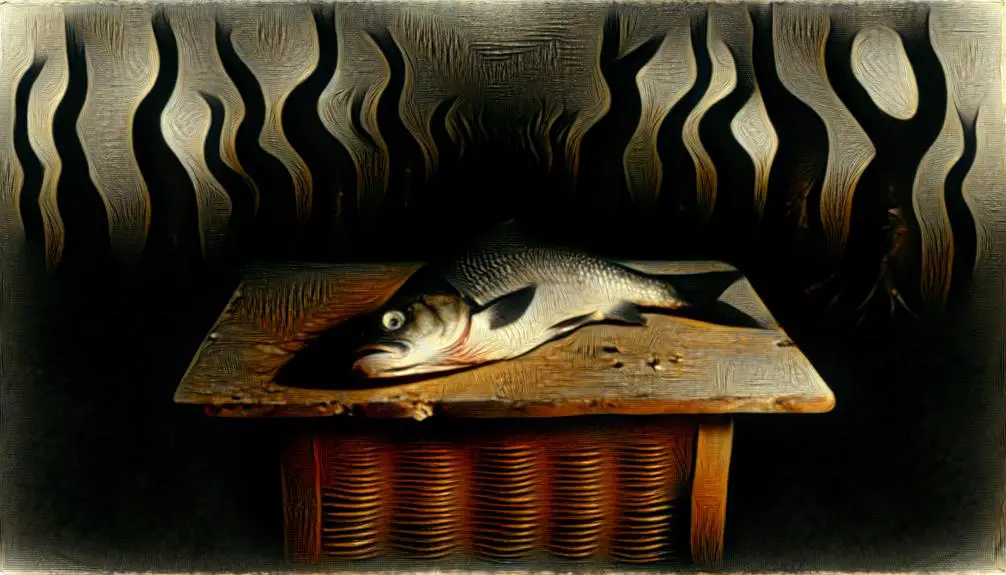
In art, the depiction of dead fish often serves as a poignant symbol of mortality, decay, and the transient nature of life. This visual metaphor can be interpreted in various ways, depending on the context and cultural background. Historically, artists have employed this motif to evoke deeper reflections on human existence and the inevitable passage of time.
Key interpretations include:
- Memento Mori: a reminder of human mortality and the transient nature of earthly pleasures.
- Environmental Commentary: highlighting the consequences of pollution and ecological neglect.
- Religious Symbolism: referencing biblical stories such as the miracle of the loaves and fishes, signifying divine providence or spiritual decay.
These interpretations underscore the multifaceted symbolism of dead fish in artistic expressions.
Tree in Art
Much like the meaningful symbolism of dead fish, trees in art serve as profound emblems of life, growth, and the passage of time, inviting viewers to contemplate themes of renewal and decay.
The tree's perennial cycle of shedding leaves and budding anew mirrors human experiences of loss and regeneration. In various art traditions, trees often symbolize knowledge, strength, and connection to the divine.
For instance, the Tree of Life in religious iconography represents interconnectedness and eternal life. Artists utilize trees' form and seasonal changes to evoke emotional responses, often juxtaposing vibrant spring foliage against barren winter branches to explore contrasts between vitality and desolation.
This rich symbolism renders the tree a versatile and enduring subject in artistic expression.
Modern Symbolism
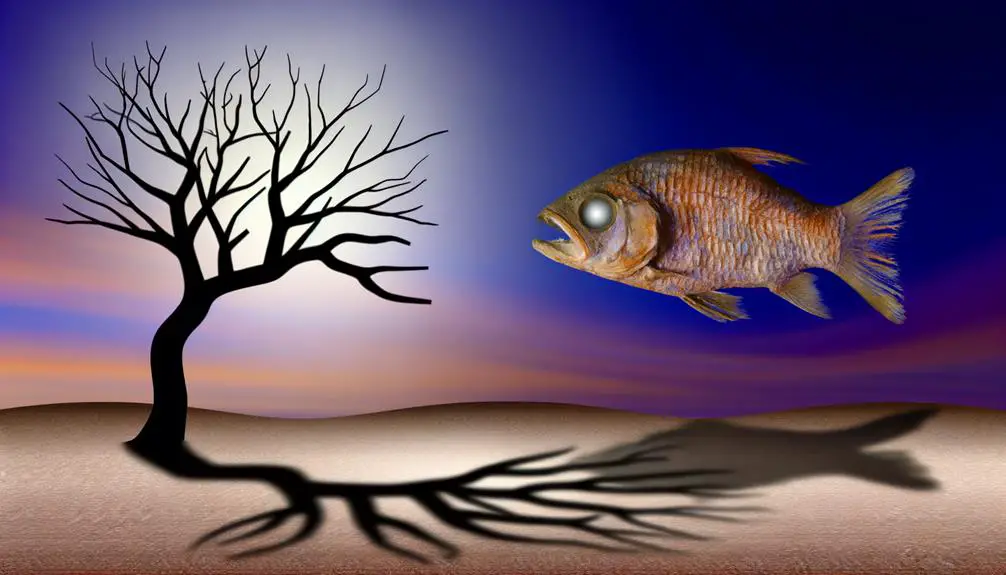
In contemporary contexts, the symbolism of dead fish and trees has undergone significant transformations, reflecting broader cultural shifts and environmental consciousness.
Modern artists often reinterpret these symbols to comment on ecological crises, loss, and regeneration, thereby imbuing them with new layers of meaning.
This evolution in artistic representation underscores the dynamic interplay between traditional symbolism and present-day concerns.
Cultural Symbolic Shifts
How have cultural symbolic changes redefined the modern meanings attributed to deceased fish and tree symbols?
In present-day contexts, these symbols have evolved beyond their traditional interpretations, reflecting deeper societal and environmental concerns.
Environmental Awareness: Deceased fish now often symbolize ecological deterioration and the urgency of environmental preservation.
Spiritual Transformation: Trees, historically symbols of life, have come to represent resilience and rejuvenation in the face of global climate change.
Consumer Critique: Both symbols are utilized in modern discourse to criticize consumerism and its impact on natural resources.
These changes underscore a growing collective consciousness about the human impact on the environment, highlighting a shift from purely symbolic to profoundly practical meanings.
Contemporary Art Interpretations
Through the lens of contemporary art, symbols like dead fish and trees are recontextualized to critique societal attitudes towards environmental degradation and sustainability. Artists utilize these symbols to evoke emotional responses and provoke critical thought about humanity's impact on nature. The juxtaposition of life and death in these motifs underscores the urgency of ecological issues.
| Symbol | Contemporary Interpretation |
|---|---|
| Dead Fish | Indicator of water pollution |
| Fallen Tree | Consequence of deforestation |
| Bare Tree | Symbol of climate change effects |
| Dead Fish | Metaphor for loss of biodiversity |
| Tree Stump | Representation of habitat loss |
This reimagining serves to not only highlight the consequences of human actions but also to inspire a collective call for sustainable practices.
Comparative Analysis
Comparing the symbolic meanings of dead fish and trees reveals a fascinating intersection of cultural beliefs and interpretations. Both symbols, while distinct, often converge in their narrative connotations. Dead fish frequently signify decay, loss, and the end of cycles, while trees embody life, growth, and continuity. These symbols can also reflect broader themes within societal contexts:
- Mortality vs. Immortality: Dead fish highlight the fragility of life, whereas trees often symbolize enduring life forces.
- Stagnation vs. Growth: Dead fish suggest stagnation or cessation, in contrast to the tree's representation of growth and renewal.
- Environmental Context: Dead fish can indicate ecological collapse, while trees may symbolize environmental resilience.
This comparative framework illuminates the rich, nuanced layers of cultural symbolism.
Personal Reflections
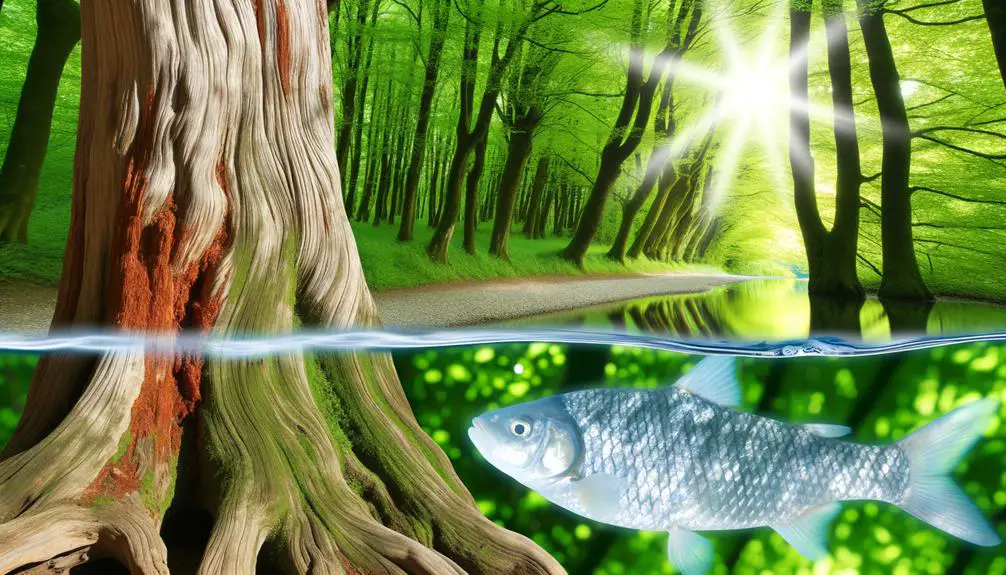
Reflecting on the symbolic meanings of dead fish and trees, one can gain profound insights into how these motifs resonate within personal and collective experiences.
Dead fish often symbolize stagnation or decay, prompting introspection about life's unfulfilled aspects or unrealized potential. Conversely, trees embody growth, resilience, and cyclical renewal, evoking a sense of continuity and connection to nature.
By juxtaposing these symbols, individuals may contemplate their own journeys: where growth has been stunted or where renewal is possible. This duality fosters a deeper understanding of life's inherent contradictions—decay alongside growth, endings alongside beginnings.
Engaging with these symbols offers a reflective space for personal and communal narratives, encouraging a balanced perspective on life's complexities.
Conclusion
The entwining of dead fish and tree symbols spans diverse cultural, mythological, and spiritual landscapes, revealing layers of historical and modern significance.
These symbols, like threads in a rich tapestry, interweave narratives of death and rebirth, decay and renewal.
Through art and mythology, they evoke a profound reflection on the cyclical nature of existence, underscoring the intricate web of life and death.
This comparative analysis illuminates their enduring resonance in contemporary symbolism.




